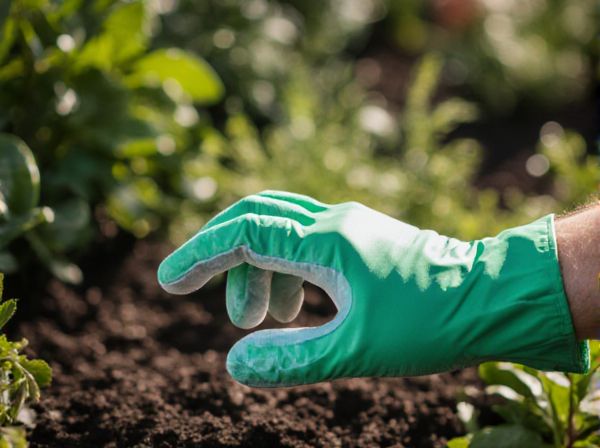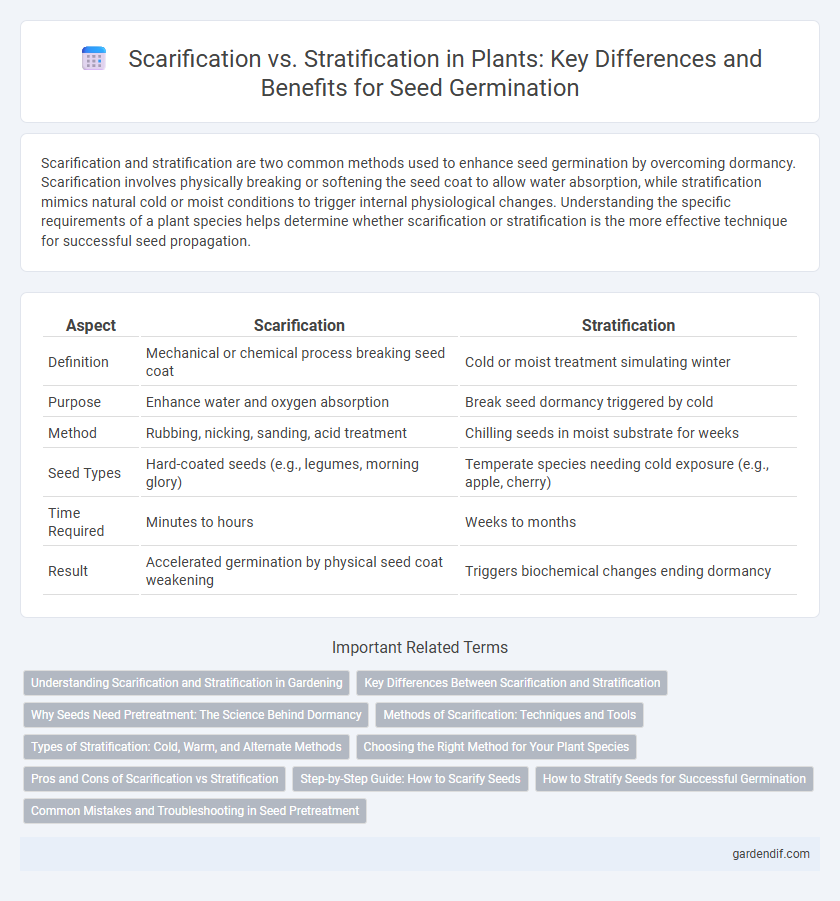
Scarification vs Stratification Illustration
Scarification and stratification are two common methods used to enhance seed germination by overcoming dormancy. Scarification involves physically breaking or softening the seed coat to allow water absorption, while stratification mimics natural cold or moist conditions to trigger internal physiological changes. Understanding the specific requirements of a plant species helps determine whether scarification or stratification is the more effective technique for successful seed propagation.
Table of Comparison
| Aspect | Scarification | Stratification |
|---|---|---|
| Definition | Mechanical or chemical process breaking seed coat | Cold or moist treatment simulating winter |
| Purpose | Enhance water and oxygen absorption | Break seed dormancy triggered by cold |
| Method | Rubbing, nicking, sanding, acid treatment | Chilling seeds in moist substrate for weeks |
| Seed Types | Hard-coated seeds (e.g., legumes, morning glory) | Temperate species needing cold exposure (e.g., apple, cherry) |
| Time Required | Minutes to hours | Weeks to months |
| Result | Accelerated germination by physical seed coat weakening | Triggers biochemical changes ending dormancy |
Understanding Scarification and Stratification in Gardening
Scarification and stratification are essential seed treatment techniques that improve germination rates by overcoming natural dormancy barriers. Scarification involves physically breaking or softening the seed coat through methods like sanding or nicking to allow water absorption. Stratification simulates natural winter conditions by exposing seeds to cold, moist temperatures, which triggers biochemical changes necessary for sprouting.
Key Differences Between Scarification and Stratification
Scarification involves physically breaking or softening the seed coat to enhance water absorption and germination rates, while stratification mimics natural winter conditions by exposing seeds to cold, moist environments to break dormancy. Scarification is commonly used for hard-coated seeds like morning glory and tamarind, whereas stratification suits temperate species such as apple and lilac seeds. Both methods improve germination but target different dormancy mechanisms in seeds.
Why Seeds Need Pretreatment: The Science Behind Dormancy
Seed dormancy is an evolutionary adaptation preventing germination under unfavorable conditions, requiring pretreatment methods like scarification and stratification to break physiological or physical barriers. Scarification mechanically or chemically disrupts the seed coat, enhancing water uptake and gas exchange necessary for germination. Stratification mimics natural cold or warm periods, triggering metabolic processes that overcome biochemical dormancy mechanisms within the embryo.
Methods of Scarification: Techniques and Tools
Scarification techniques involve physically altering seeds to break their hard outer coat, enhancing water absorption and germination rates. Common methods include mechanical scarification using sandpaper or a knife to nick the seed coat, thermal scarification by briefly exposing seeds to hot water or fire, and chemical scarification with mild acids like sulfuric acid to weaken seed coats. These approaches require careful handling to avoid damaging the embryo while promoting faster and more uniform seed germination.
Types of Stratification: Cold, Warm, and Alternate Methods
Cold stratification mimics winter conditions by exposing seeds to moist, low temperatures between 1-5degC, which breaks dormancy in species like apple and maple. Warm stratification involves keeping seeds in a moist environment at 15-25degC, suitable for tropical plants such as hibiscus that require a warm period to germinate. Alternate stratification combines cycles of warm and cold treatments, enhancing germination rates for seeds with complex dormancy like lilac and dogwood.
Choosing the Right Method for Your Plant Species
Scarification involves physically breaking or softening a seed's hard outer coat to promote water absorption and germination, ideal for species like morning glories, sweet peas, and many legumes. Stratification mimics natural winter conditions by exposing seeds to cold, moist environments, benefiting temperate species such as apples, cherries, and many perennials. Selecting the correct method depends on the seed coat hardness and specific dormancy requirements of the plant, ensuring higher germination rates and successful propagation.
Pros and Cons of Scarification vs Stratification
Scarification enhances seed germination by breaking hard seed coats through mechanical or chemical methods, promoting faster and more uniform sprouting but can damage seeds if done improperly. Stratification mimics natural cold and moist conditions to stimulate embryo development, improving germination rates for species that require dormancy breaking yet demands patience due to longer treatment times. Choosing between scarification and stratification depends on seed type, as tough-coated seeds benefit more from scarification, while seeds with physiological dormancy respond better to stratification.
Step-by-Step Guide: How to Scarify Seeds
Scarification involves physically breaking or softening the seed coat to enhance water absorption and promote germination, commonly using methods like sanding with fine grit sandpaper or nicking the seed coat with a sharp blade. After preparing seeds by scarification, soak them in water for 12 to 24 hours to further soften the seed coat and trigger the germination process. Ensure seeds are planted promptly in suitable soil conditions to optimize germination rates and plant growth.
How to Stratify Seeds for Successful Germination
Stratifying seeds involves mimicking natural winter conditions by exposing them to cold, moist environments to break seed dormancy and promote germination. To stratify seeds effectively, place them in a damp medium like sand or peat moss inside a sealed plastic bag and store them in a refrigerator at temperatures between 1-5degC (34-41degF) for 4 to 12 weeks, depending on the species. Regularly check moisture levels to prevent drying out and ensure successful germination upon planting.
Common Mistakes and Troubleshooting in Seed Pretreatment
Common mistakes in seed pretreatment often involve confusing scarification and stratification processes, leading to ineffective germination. Scarification requires physical or chemical abrasion to break hard seed coats, while stratification simulates natural cold or moist conditions to overcome dormancy. Troubleshooting includes ensuring scarification is not too harsh to damage embryos and confirming stratification temperature and duration mimic natural seasonal cycles precisely for optimal seed viability.
Scarification vs Stratification Infographic

 gardendif.com
gardendif.com